NCERT Exemplar Class 8 Maths Chapter 1 Rational Numbers are part of NCERT Exemplar Class 8 Maths . Here we have given NCERT Exemplar Class 8 Maths Chapter 1 Rational Numbers.
NCERT Exemplar Class 8 Maths Chapter 1 Rational Numbers
Multiple Choice Questions
Question . 1 A number which can be expressed as \(\frac { p }{ q }\) , where p and q are integers and \( q\neq 0\) is
(a) natural number (b) whole number
(c) integer (d) rational number
Solution.
(d) A number which can be expressed as \(\frac { p }{ q }\), where p and q are integers and \( q\neq 0\) is a rational number.
Question . 2 A number of the form \(\frac { p }{ q }\) is said to be a rational number, if
(a) p, q are integers (b) p, q are integers and \( q\neq 0\)
(c) p, q are integers and \( p\neq 0\) (d) p, q are integers and \( p\neq 0\), also \( q\neq 0\)
Solution.
(b) A number of the form \(\frac { p }{ q }\) is said to be a rational number, if p and q are integers and
Question . 3 The numerical expression \( \frac { 3 }{ 8 } +\frac { (-5) }{ 7 } =\frac { -19 }{ 56 }\) shows that
(a)rational numbers are closed under addition
(b) rational numbers are not closed under addition
(c) rational numbers are closed under multiplication
(d) addition of rational numbers is not commutative
Solution.
(b) We have \( \frac { 3 }{ 8 } +\frac { (-5) }{ 7 } =\frac { -19 }{ 56 }\)
Show that rational numbers are closed under addition.
[\(\frac { 3 }{ 8 }\) and\( \frac { -5 }{ 7 }\) are rational numbers and their addition is \(\frac { -19 }{ 56 }\) which is also a rational number]
Note The sum of any two rational numbers is always a rational number.
Question . 4 Which of the following is not true?
(a) rational numbers are closed under addition
(b) rational numbers are closed under subtraction
(c) rational numbers are closed under multiplication
(d) rational numbers are closed under division
Solution.
(d) Rational numbers are not closed under division.
As, 1 and 0 are the rational numbers but \( \frac { 1 }{ 0 }\) is not defined.
Question . 5 \(-\frac { 3 }{ 8 } +\frac { 1 }{ 7 } =\frac { 1 }{ 7 } +[\frac { -3 }{ 8 } ]\) is an example to show that
(a) addition of rational numbers is commutative
(b) rational numbers are closed under addition
(c) addition of rational numbers is associative
(d) rational numbers are distributive under addition
Solution.
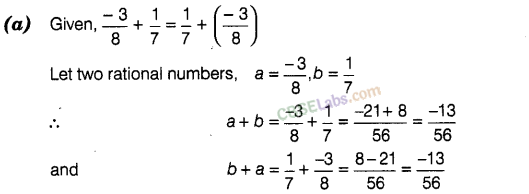
Clearly, a + b = b + a
So, addition is communication for rational numbers
Question . 6 Which of the following expressions shows that rational numbers are associative under multiplication.

Solution.

So, a x (b x c) = (a x b) x c
Hence, the given expression shows that rational numbers are associative under multiplication.
Question . 7 Zero (0) is
(a) the identity for addition of rational numbers
(b) the identity for subtraction of rational numbers
(c) the identity for multiplication of rational numbers
(d) the identity for division of rational numbers
Solution .
(a) Zero (0) is the identity for addition of rational numbers.
That means,
If a is a rational number.
Then, a+0=0+a = a
Note Zero (0) is also the additive identity for integers and whole number as well.
Question . 8 One (1) is
(a) the identity for addition of rational numbers
(b) the identity for subtraction of rational numbers
(c) the identity for multiplication of rational numbers
(d) the identity for division of rational numbers
Solution .
(c) One (1) is the identity for multiplication of rational numbers.
That means,
If a is a rational number.
Then, a-1 = 1-a = a
Note One (1) is the multiplication identity for integers and whole number also.
Question . 9 The additive inverse of \(\frac { -7 }{ 19 }\) is

Solution .
(b) We know that, if a and b are the additive inverse of each other, then a + b = 0
Suppose, x is the additive inverse of \(\frac { -7 }{ 19 }\)

Question . 10 Multiplicative inverse of a negative rational number is
(a) a positive rational number (b) a negative rational number
(c) 0 (d) 1
Solution.
(b) We know that, the product of two rational numbers is 1, taken they are multiplication inverse of each other, e.g.
Suppose, p is negative rational number, i.e.
\(\frac { 1 }{ p }\) is the multiplicative inverse of-p, then, -p x \(\frac { 1 }{ -p }\) = 1
Hence, multiplicative inverse of a negative rational number is a negative rational number.
Question. 11 If x + 0 = 0 + x = x, which is rational number, then 0 is called
(a) identity for addition of rational numbers
(b) additive inverse of x
(c) multiplicative inverse of x
(d) reciprocal of x
Solution .
(a) We know that, the sum of any rational number and zero (0) is the rational number itself.
Now, x + 0 = 0+ x= x, which is a rational number, then 0 is called identity for addition of rational numbers.
Question . 12 To get the product 1, we should multiply \( \frac { 8 }{ 21 }\) by
![]()
Solution .

Question . 13 – (-x) is same as
(a)-x (b)x (c)\(\frac { 1 }{ x }\) (d)\(\frac { -1 }{ x }\)
Solution .
(b) -(-x) = x
Negative of negative rational number is equal to positive rational number.
Question . 14 The multiplicative inverse of \( -1\frac { 1 }{ 7 }\) is
![]()
Solution .
(d) We know that, if the product of two rational numbers is 1, then they are multiplicative inverse of each other.
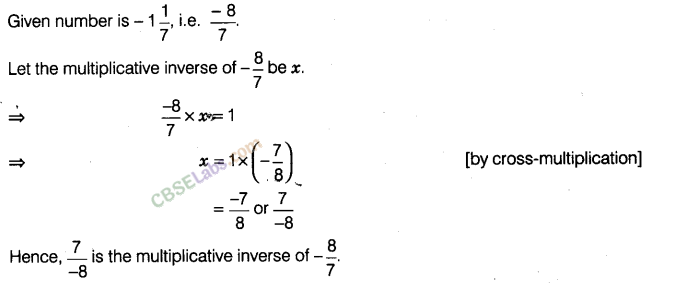
Question . 15 If x is any rational number, then x + 0 is equal to
(a)x (b) 0 (c)-x (d) Not defined
Solution .
(a) If x is any rational number, then x + 0 = x [0 is the additive identity]
Question . 16 The reciprocal of 1 is ;
(a) 1 (b) -1 (c) 0 (d) Not defined
Solution .
(a) The reciprocal of 1 is the number itself.
Question . 17 The reciprocal of -1 is
(a) 1 (b) -1 (c) 0 (d) Not defined
Solution .
(b) The reciprocal of -1 is the number itself.
Question . 18 The reciprocal of 0 is
(a) 1 (b) -1 (c) 0 (d) Not defined
Solution .
(d) The reciprocal of 0 is not defined.
Question . 19 The reciprocal of any rational number \(\frac { p }{ q }\) , where p and q are integers and \( q\neq 0\) is
(a)\(\frac { p }{ q }\) (b)1 (c)0 (d)\(\frac { q }{ p }\)
Solution .
(d) The reciprocal of any rational number \(\frac { p }{ q }\), where p and q are integers and \( q\neq 0\) is \(\frac { q }{ p }\)
Question . 20 If y is the reciprocal of rational number x, then the reciprocal of y will be
(a)x (b) y (c) \(\frac { x }{ y }\) (d) \(\frac { y }{ x }\)
Solution .
(a) If y be the reciprocal of rational number x, i.e. y = \(\frac { 1 }{ x }\) or x = \(\frac { 1 }{ y }\).
Hence, the reciprocal of y will be x.
Question .21

Solution .
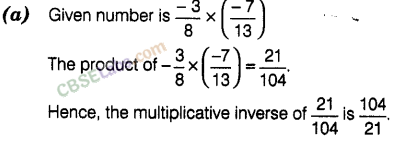
Question . 22 Which of the following is an example of distributive property of multiplication over addition for rational numbers.
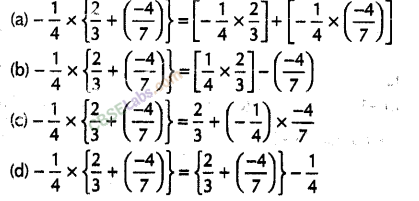
Solution .
We know that, the distributive property of multiplication over addition for rational numbers can be expressed as a x (b + c) = ab + ac, where a, b and c are rational numbers.

is the example of distributive property of multiplication over addition for rational numbers.
Question . 23 Between two given rational numbers, we can find
(a) one and only one rational number
(b) only two rational numbers
(c) only ten rational numbers
(d) infinitely many rational numbers
Solution .
(d) We can find infinite many rational numbers between two given rational numbers.
Question .24

(a) Between x and y
(b) Less than x and y both
(c) Greater than x and y both
(d) Less than x but greater than y
Solution .
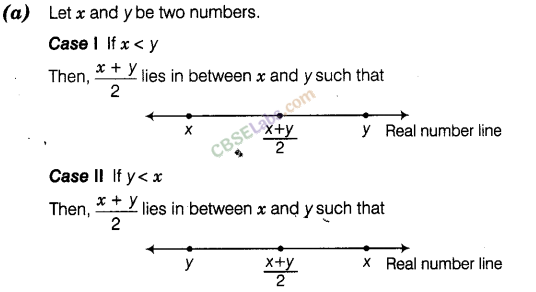
Question . 25 Which of the following statements is always true?
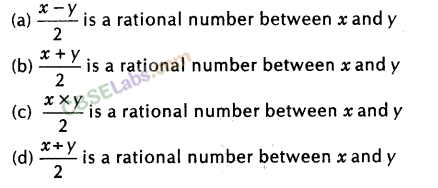
Solution .

Fill in the Blanks
In questions 26 to 47, fill in the blanks to make the statements true.
Question . 26 The equivalent of \( \frac { 5 }{ 7 } \) whose numerator is 45, is —.
Solution .

Question . 27 The equivalent rational number of \( \frac { 7 }{ 9} \) , whose denominator is 45 is——————.
Solution .

Question . 28 Between the numbers \(\frac {15 }{ 20} \) and \(\frac { 35 }{ 40} \), the greater number is———————-.
Solution .
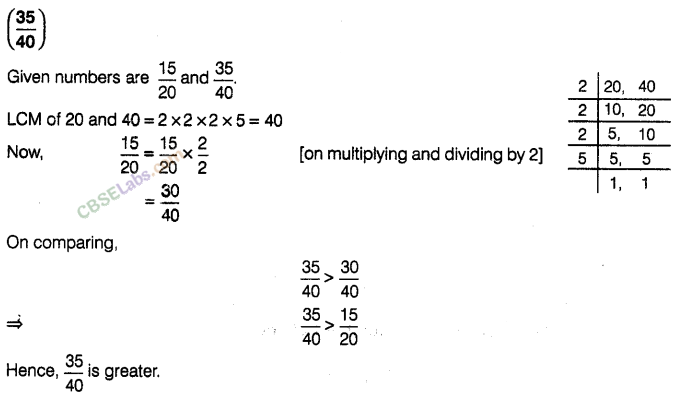
Question . 29 The reciprocal of a positive rational number is—————.
Solution .

Question . 30 The reciprocal of a negative rational number is——————–.
Solution .

Question. 31 Zero has————reciprocal.
Solution .

Question. 32 The numbers ————–and————–are their own reciprocal.
Solution .

Question . 33 If y is the reciprocal of x, then the reciprocal of \({ y }^{ 2 }\) in terms of x will be—————-.
Solution .

Question . 34

Solution .
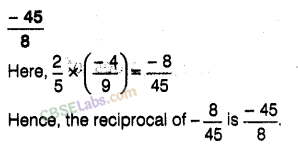
Question . 35
![]()
Solution .
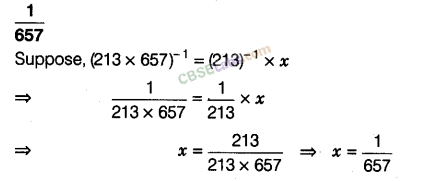
Question . 36 The negative of 1 is—————-.
Solution .
-1 The negative of 1 is -1.
Question . 37

Solution .

Question . 38 \(\frac { -5 }{ 7 }\) is———————than -3.
Solution .
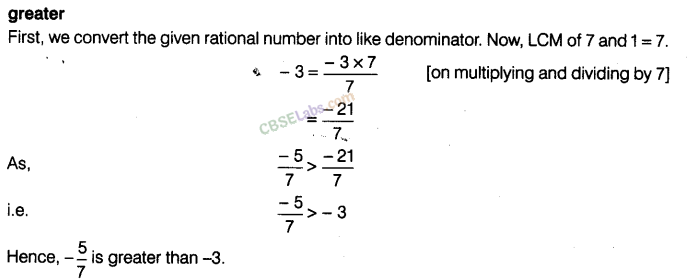
Question . 39 There are rational numbers between any two rational numbers.
Solution .
Infinite
There are infinite rational numbers between any two rational numbers.
Question . 40 The rational numbers \(\frac { 1 }{ 3 }\) and \(\frac { -1 }{ 3 }\) are on the sides of zero on the number line.
Solution .

Question . 41 The negative of a negative rational number is always a—————-rational
number.
Solution.
positive
Let x be a positive rational number.
Then, – x be a negative rational number.
Now, negative of a negative rational number = – (- x)= x =positive rational number.
Question . 42 Rational numbers can be added or multiplied in any————-.
Solution .
order
Rational numbers can be added or multiplied in any order and this concept is known as commutative property.
Question . 43 The reciprocal of \(\frac { -5 }{ 7 }\) is——————.
Solution .
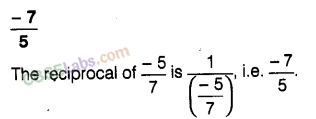
Question . 44 The multiplicative inverse of \(\frac { 4 }{ 3 }\) is———–.
Solution .
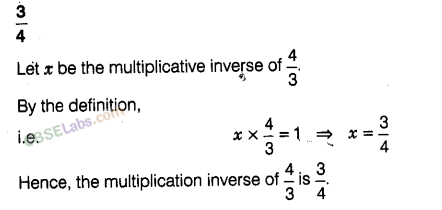
Question . 45 The rational number 10.11 in the form \(\frac { p }{ q }\) is ——–.
Solution .
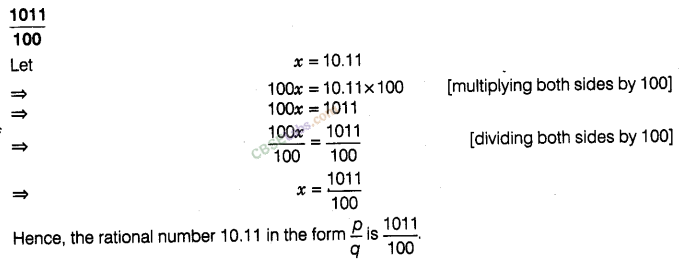
Question .46

Solution .
![]()
Question . 47 The two rational numbers lying between -2 and -5 with denominator as 1 are———–and————.
Solution .

True/False
In questions 48 to 99, state whether the given statements are True or False.
Question . 48 If \(\frac { x }{ y }\)is a rational number, then y is always a whole number.
Solution .
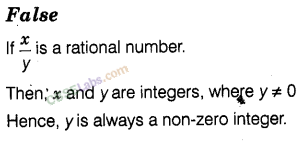
Question . 49 If \(\frac { p }{ q }\) is a rational number, then p Cannot be equal to zero.
Solution .
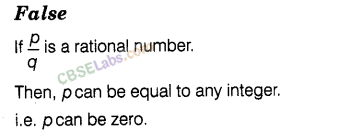
Question . 50 If \(\frac { r }{ s }\) is a rational number, then s cannot be equal to zero.
Solution .
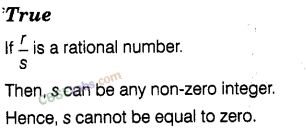
Question . 51 \(\frac { 5 }{ 6 }\) lies between \(\frac { 2 }{ 3 }\) and 1.
Solution .
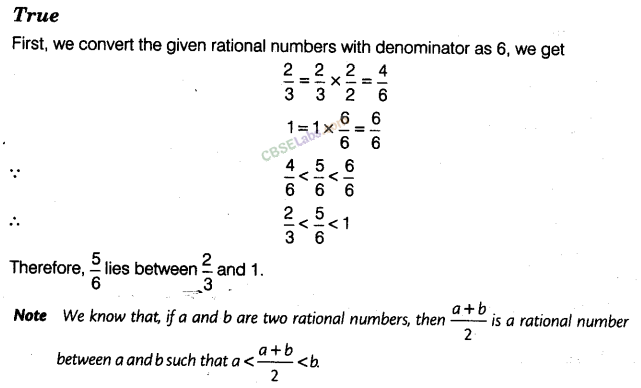
Question . 52 \(\frac { 5 }{ 10 }\) lies between \(\frac { 1 }{ 2 }\) and 1.
Solution .
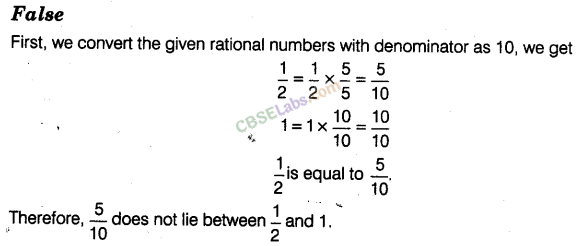
Question . 53 \(\frac { 5 }{ 10 }\) lies between -3 and 4.
Solution .
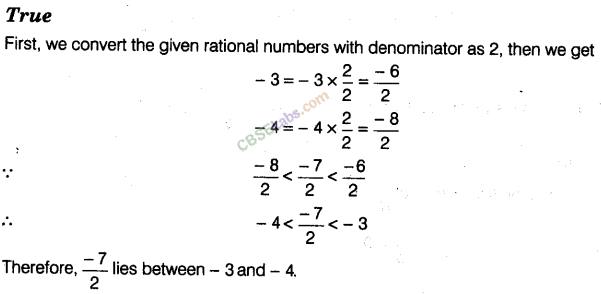
Question . 54 \(\frac { 9 }{ 6 }\) lies between 1 and 2.
Solution .
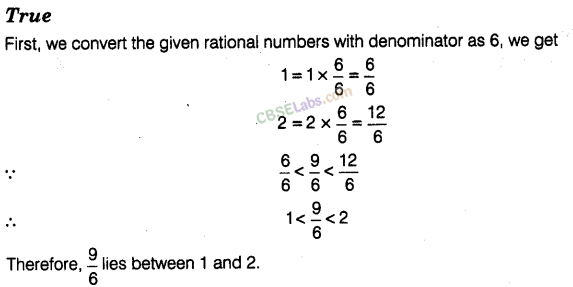
Question . 55 If \(a\neq 0\) the multiplicative inverse of \(\frac { a }{ b }\) is \(\frac { b }{ a }\) .
Solution .

Question . 56 The multiplicative inverse of \(\frac { -3 }{ 5 }\) is \(\frac { 5 }{ 3 }\) .
Solution .

Question . 57 The additive inverse of \(\frac { 1 }{ 2 }\) is -2.
Solution .
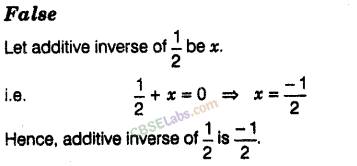
Question . 58

Solution .
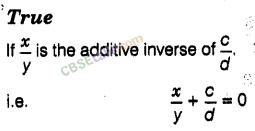
Question . 59 For every rational number x, x + 1 = x.
Solution .
False
For every rational number , x + 0 = x
Question . 60

Solution .
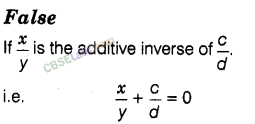
Question . 61 The reciprocal of a non-zero rational number \(\frac { q }{ p }\) is the rational number \(\frac { q }{ p }\).
Solution .
False
The reciprocal of a non-zero rational number \(\frac { q }{ p }\) . is the rational number\(\frac { p }{ q }\)
Question . 62 If x + y = 0, then -y is known as the negative of x, where x and y are rational numbers.
Solution .
False
If x and y are rational numbers and x+ y = 0.
Then, y is known as the negative of x.
Question . 63 The negative of the negative of any rational number is the number itself.
Solution .
True
Let x be a positive rational number. Then, -x be a negative rational number.
Now, negative of negative rational number = -(-x)= x = Positive rational number
Question . 64 The negative of 0 does not exist.
Solution .
True
Since, zero is neither a positive integer nor a negative integer.
Question . 65 The negative of 1 is 1 itself.
Solution .
False
The negative of 1 is -1.
Question . 66 For all rational numbers x and y,x-y = y- x
Solution .
False
For all rational numbers x and y,
x-y = -(y-x)
Question . 67 For all rational numbers x and y, x x y = y x x.
Solution .
True
For all rational numbers x and y,
x x y= y x x
Question . 68 For every rational number x, x x 0 = x.
Solution .
False
For every rational number x,
x x 0 = 0
Question . 69 For every rational numbers x, y and z, x + (y x z) = (x + y) x (x + z)
Solution .
False
For all rational numbers a, b and c.
a(b + c) = ab+ ac
Question . 70 For all rational numbers a, b and c,a (b + c) = ab + bc.
Solution .
False
As, addition is not distributive over multiplication.
Question . 71 1 is the only number which is its own reciprocal.
Solution .
False
Reciprocal of 1 is 1 and reciprocal of -1 is -1.
Question . 72 -1 is not the reciprocal of any rational number.
Solution .
False
-1 is the reciprocal of -1.
Question . 73 For any rational number x, x + (-1) = – x.
Solution .
False
For every rational number x,
x x (-1) = – x
Question . 74 For rational numbers x and y, if x < y, then x – y is a positive rational number.
Solution .
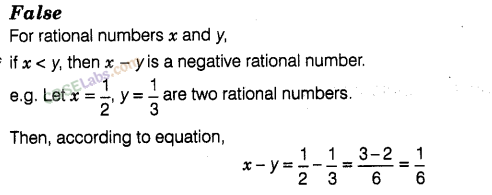
Question . 75 If x and y are negative rational numbers, then so is x + y.
Solution .
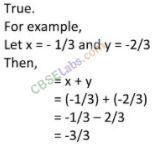
Question . 76 Between any two rational numbers there are exactly ten rational . numbers.
Solution .
False
There are infinite rational numbers between any two rational numbers.
Question . 77 Rational numbers are closed under addition and multiplication but not under subtraction.
Solution .
False
Rational numbers are closed under addition, subtraction and multiplication.
Question . 78 Subtraction of rational number is commutative.
Solution .
False
Subtraction of rational numbers is not commutative, i.e. \(a-b\neq b-a\)
where, a and b are rational numbers.
Question . 79 \(-\frac { 3 }{ 4 }\) is smaller than -2 .
Solution .
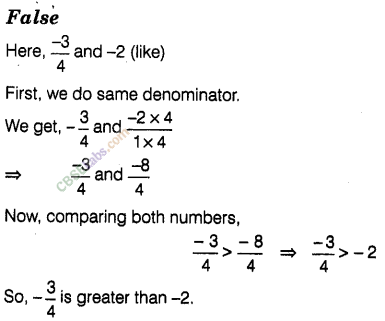
Question . 80 0 is a rational number.
Solution .

Question . 81 All positive rational numbers lie between 0 and 1000.
Solution .
False
Infinite positive rational numbers lie on the right side of 0 on the number line.
Question. 82 The population of India in 2004-05 is a rational number.
Solution.
True
The population of India in 2004-05 is a rational number.
Question. 83 There are countless rational numbers between \(-\frac { 5 }{ 6 }\) and \(-\frac { 8 }{ 9 }\).
Solution.

Question. 84

Solution.
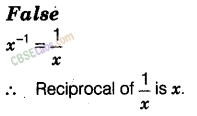
Question. 85 The rational number \(-\frac { 57 }{ 23 }\) lies to the left of zero on the number line.
Solution.
False
Since,\(-\frac { 57 }{ 23 }\) is a positive rational number.
So, it lies on the right of zero on the number line.
Question .86 The rational number \(-\frac { 7 }{ -4 }\) lies to the right of zero on the number line.
Solution .
False
Since, \(-\frac { 7 }{ -4 }\) is a negative rational number.
So, it lies on the left of zero on the number line.
Question .87 The rational number \(-\frac { -8 }{ -3 }\) lies neither to the right nor to the left of zero on the number line.
Solution .
False
\(-\frac { -8 }{ -3 }\) = \(-\frac { 8 }{ 3 }\) is a positive rational number.
Hence, it lies on the right of zero on the number line.
Question . 88 The rational numbers \(-\frac { 1 }{ 2 }\) and -1 are on the opposite sides of zero on the number tine.
Solution .
True
Since, positive rational number and negative rational number are on the opposite sides of zero on the number line.’
Hence, \(-\frac { 1 }{ 2 }\) and -1 are on the opposite sides of zero on the number line.
Question . 89 Every fraction is a rational number.
Solution .

Question . 90 Every integer is a rational number.
Solution .
True
Every integer is a rational number whose denominator remain 1.
Question . 91 The rational numbers can be represented on the number line.
Solution .
True
The rational numbers can be represented on the number line.
Question . 92 The negative of a negative rational number is a positive rational number.
Solution .
True
Let be a positive rational number.
Then, – x be the negative rational number.
Hence, negative of negative rational number = – (- x)= x = Positive rational number
Question . 93 If x and y are two rational numbers such that x > y, then x – y is always a positive rational number.
Solution .
True
If x and y are two rational numbers such that x > y.
Then, there are three possible cases, i.e.
Case I x and y both are positive. ‘
Case II x is positive and y is negative.
Case III x and y both are negative.
In all three cases, x – y is always a positive rational number.
Question . 94 0 is the smallest rational number.
Solution .
False
As the smallest rational number does not exist.
Question .95 Every whole number is an integer.
Solution .
True
W (whole numbers) = {0,1,2, 3 }
Z (integers) = {…- 3, – 2, -1, 0,1,2, 3,…}
Every whole number is an integer, but every integer is not a whole number.
Question .96 Every whole number is a rational number.
Solution .
True
Every whole number can be written in the form of \(-\frac { p }{ q }\), where p, q are integers and \(q\neq 0\).
Hence, every whole number is a rational number.
Question . 97 0 is whole number but it is not a rational number.
Solution .
False
0 is a whole number and also a rational number.
Question . 98 The rational numbers \(-\frac { 1 }{ 2 }\)and \(-\frac -{ 5 }{ 2}\) are on the opposite sides of zero on the number line.
Solution .
True
Positive rational number and negative rational number remain on opposite sides of zero on the number line.
Question .99 Rational numbers can be added (or multiplied) in any order

Solution .

Question . 100 Solve the following, select the rational numbers from the list which are also the integers.

Solution .
From the given rational numbers, the numbers whose denominator is 1 and the numbers whose numerator is the multiple of denominator are the integers.

Question . 101 Select those which can be written as a rational number with denominator 4 in their lowest form

Solution .
From the given rational numbers, the number with denominator 4 in their lowest form is \(-\frac { 5 }{ -4 }\)
Question . 102 Using suitable rearrangement and find the sum
![]()
Solution .
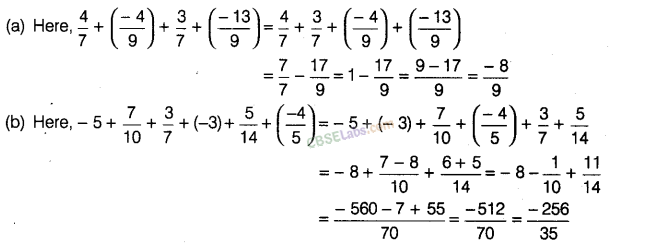
Question . 103 Verify – (-x) = x for

Solution .

Question . 104 Give one example each to show that the rational numbers are closed under addition, subtraction and multiplication. Are rational numbers closed under division? Give two examples in support of your answer.
Solution .
We know that, rational numbers are closed under addition, subtraction and multiplication. We can understand this from the following examples.
Rational numbers are closed under addition
![]()
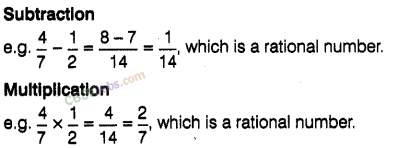
But rational are not closed under division. If zero is excluded from the collection of rational numbers, then we can say that rational numbers are closed under division.
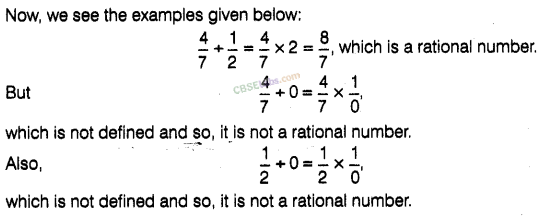
Question . 105 Verify the property x + y = y + x of rational numbers by taking

Solution .
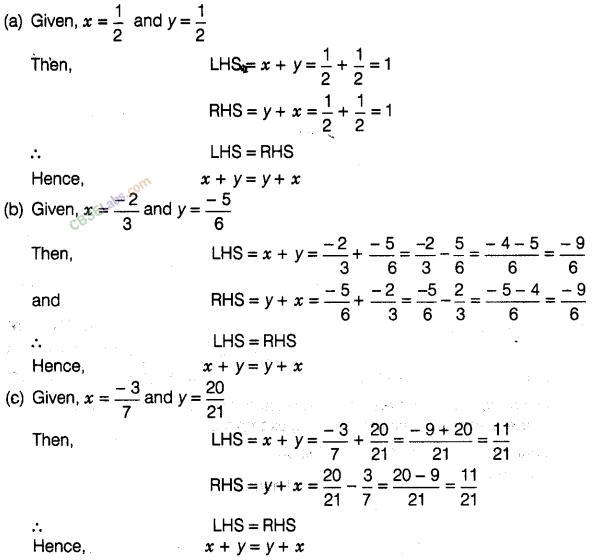
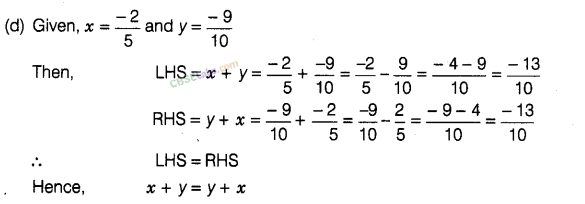
Question . 106 Simplify each of the following by using suitable property. Also, name the property.

Solution .
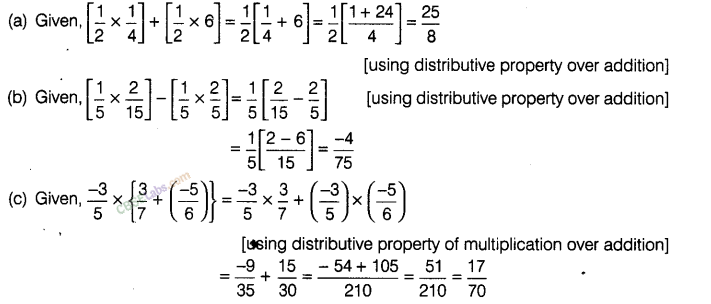
Question . 107

Solution .

Question . 108 Verify the property x x y = y x x of rational numbers by using

Solution .
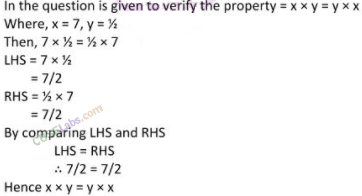
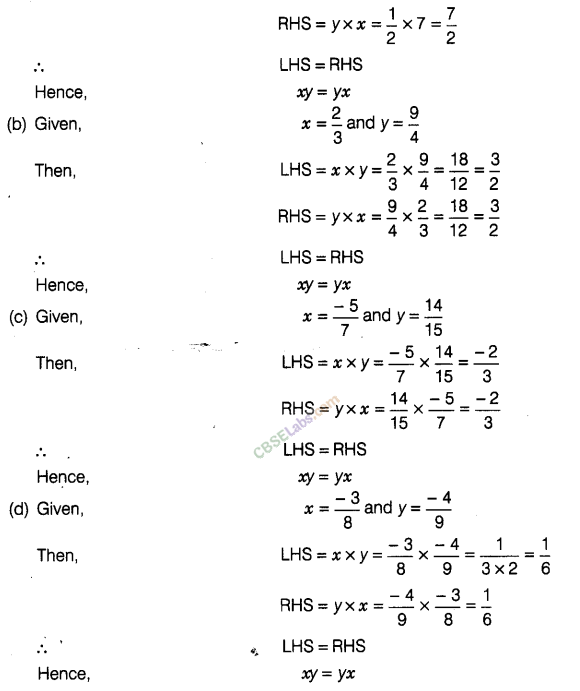
Question . 109 Verify the property x x (y x z)=i.(x x y) x z of rational numbers by using

Solution .
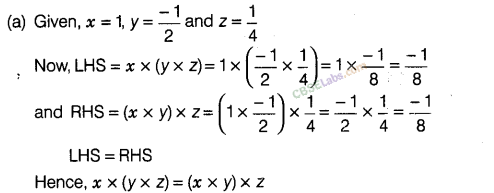
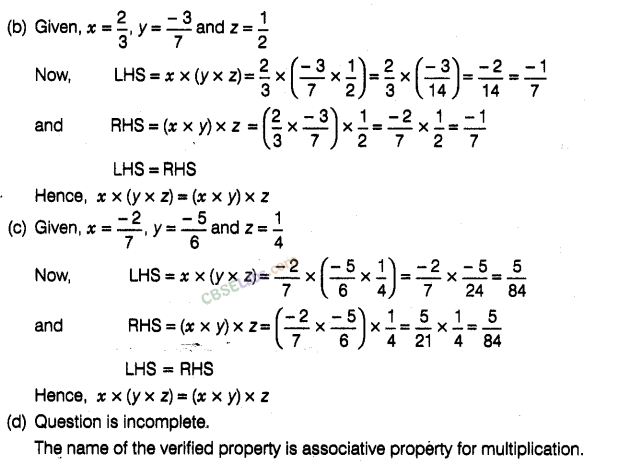
Question . 110 Verify the property x x (y + z) = x x y + x x z of rational numbers by taking

Solution .
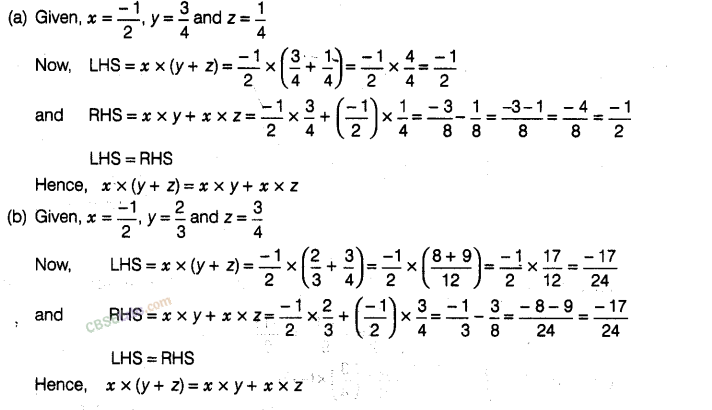
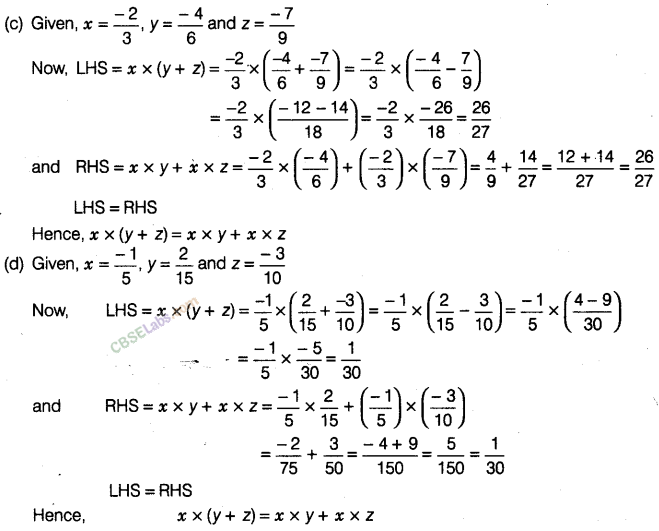
Question . 111 Use the distributivity of multiplication of rational numbers over addition to simplify

Solution .
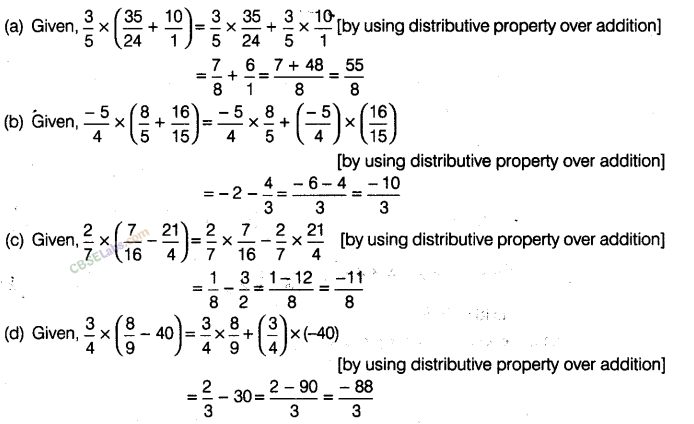
Question. 112 Simplify

Solution .
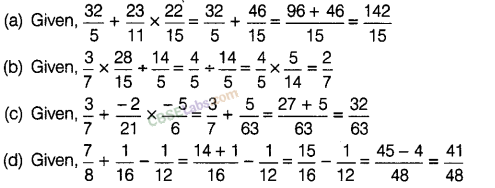
Question. 113 Identify the rational number that does not belong with the other three. Explain your reasoning

Solution .
does not belong with the other three. Since,\( \frac { -7 }{ 3 }\) as it is smaller than -1 whereas rest of the numbers are greater than -1.
Question. 114 The cost of \( \frac { 19 }{ 4 }\) m of wire is Rs \( \frac { 171 }{ 2 }\) Find the cost of one metre of the wire.
Solution .

Question. 115 A train travels \( \frac { 1445 }{ 2 }\) km in \( \frac { 17 }{ 2 }\) h. Find the speed of the train in km/h.
Solution .
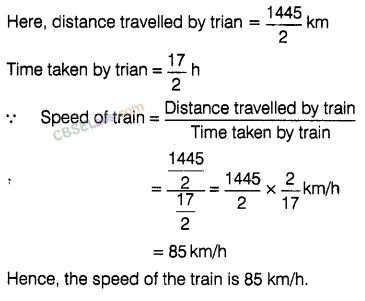
Question. 116 If 16 shirts of equal size can be made out of 24m of cloth, how much cloth is needed for making one shirt?
Solution .
If 16 shirts are to be made by cloth of 24 m
Then, 1 shirt is to be made by cloth of = \( \frac { 24 }{ 16 }\) m = \( \frac { 3 }{ 2 }\) m = 1.5 m
Hence, 1.5 m cloth is needed for making one shirt.
Question. 117 \( \frac { 7 }{ 11 }\) of all the money in Hamid’s bank account is Rs 77000. How much money does Hamid have in his bank account?
Solution .
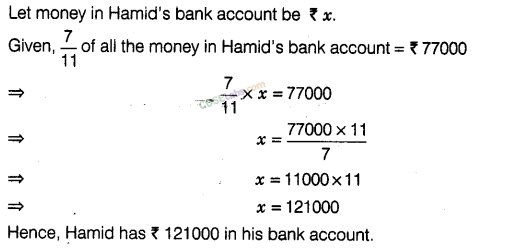
Question. 118 A 117\( \frac { 1 }{ 3 }\) m long rope is cut into equal pieces measuring 7\( \frac { 1 }{ 3 }\) m each. How many such small pieces are these?
Solution .
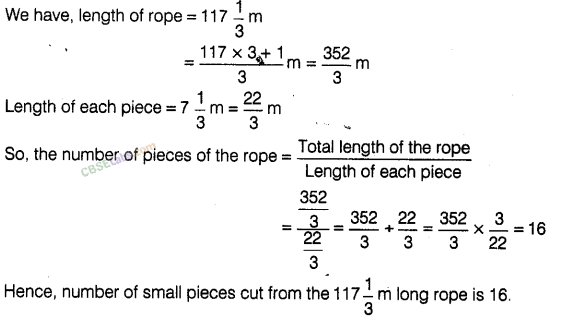
Question. 119 \( \frac { 1 }{ 6 }\) of the class students are above average, \( \frac { 1 }{ 4 }\) are average and rest are
below average. If there are 48 students in all, how many students are below average in the class?
Solution .
Number of above average students = \( \frac { 1 }{ 6 }\) of the class students
Number of average students = \( \frac { 1 }{ 4 }\)of the class students
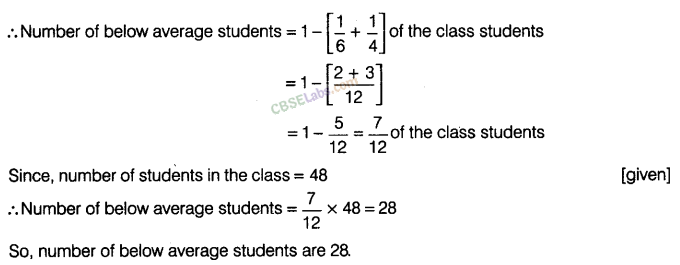
Question. 120 \( \frac { 2 }{ 5 }\)of total number of students of a school come by car while \( \frac { 1 }{ 4 }\) of
students come by bus to school. All the other students walk to school of which \( \frac { 1 }{ 3 }\)walk on their own and the rest are escorted by their parents. If 224 students come to school walking on their own, how many students study in that school?
Solution .
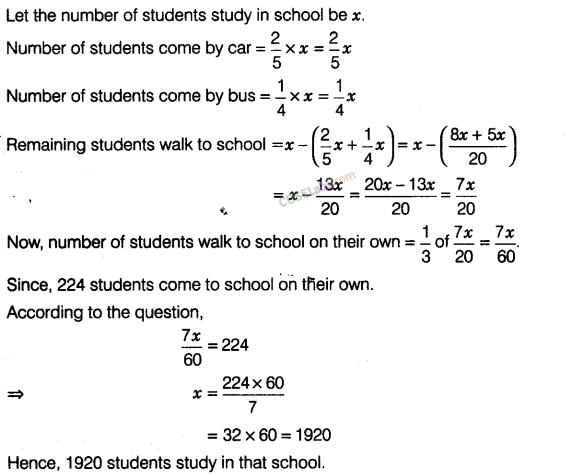
Question. 121 Huma, Hubna and Seema received a total of Rs 2016 as monthly allowance from their mother such that Seema gets \( \frac { 1 }{ 2 }\) of what Hubna gets and Huma gets 1\( \frac { 2 }{ 3 }\) times Seema’s share. How much money do the three sisters get individually?
Solution .
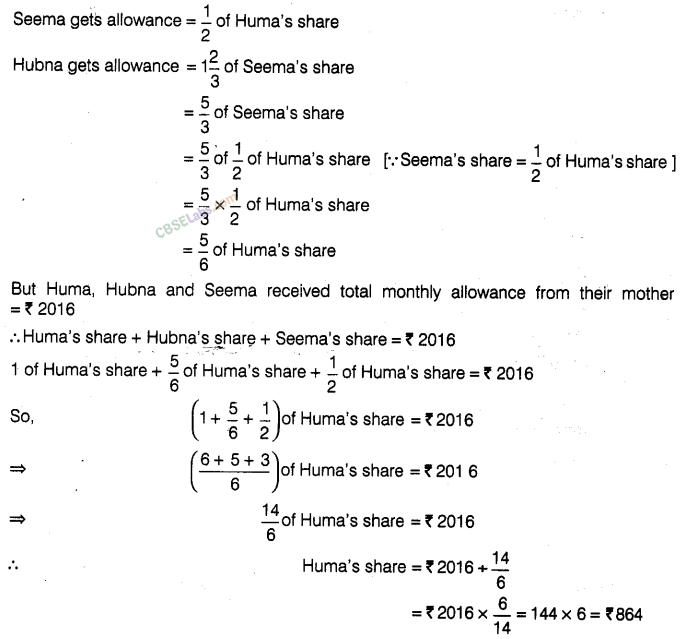

Question. 122 A mother and her two daughters got a room constructed for Rs 62000. The elder daughter contributes \( \frac { 3 }{ 8 }\)of her mother’s contribution while the younger daughter contributes \( \frac { 1 }{ 2 }\)of her mother’s share. How much do the three contribute individually?
Solution .
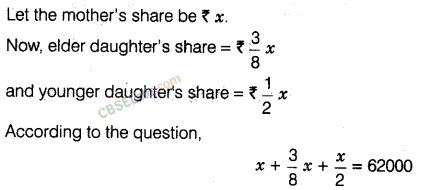
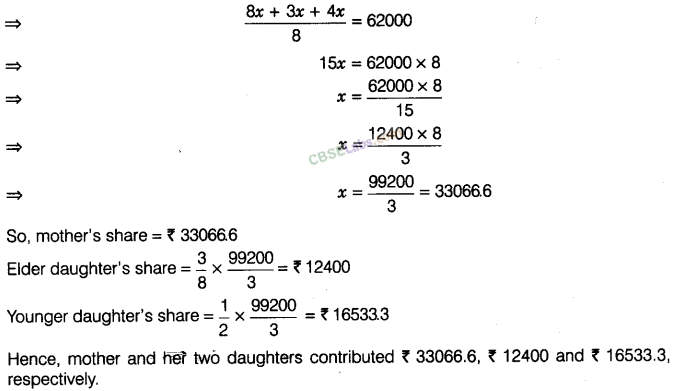
Question. 123 Tell which property allows you to compare

Solution .

Question. 124 Name the property used in each of the following:
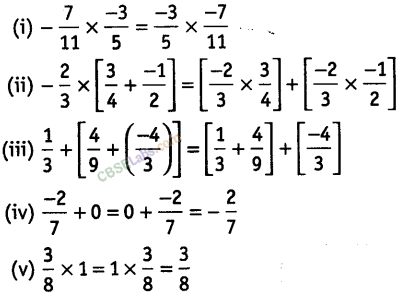
Solution .
(i) Commutative property over multiplication
(ii) Distributive property over addition
(iii) Associative property over addition
(iv) Existence of additive identity
(v) Existence of multiplicative identity
Question. 125 Find the multiplicative inverse of(i)-1\( \frac { 1 }{ 8 }\) (ii)3 \( \frac { 1 }{ 3 }\)
Solution .
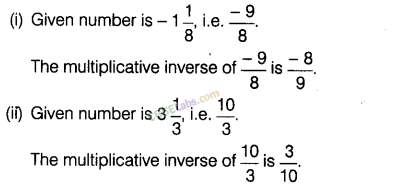
Question. 126 Arrange the numbers is \( \frac { 1 }{ 4 }\) , \( \frac { 13 }{ 16 }\) , \( \frac { 5 }{ 8 }\)in the descending order.
Solution .
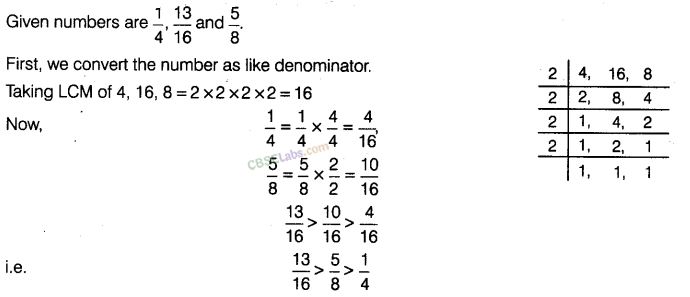
Question. 127 The product of two rational numbers is \( \frac { -14 }{ 27 }\) If one of the numbers be \( \frac { 7 }{ 9 }\)
find the other.
Solution .
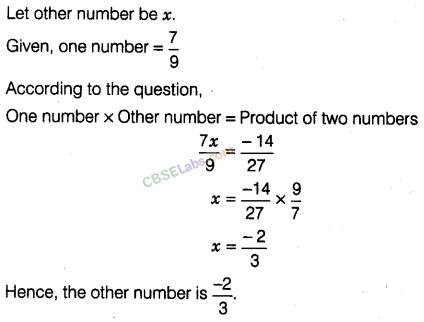
Question. 128 By what numbers should we multiply \( \frac { -15 }{ 20 }\) so that the product may be \( \frac { -5 }{ 7 }\) ?
Solution .
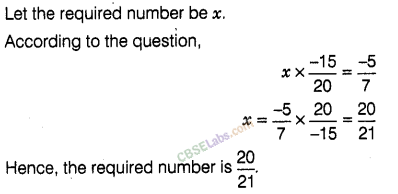
Question. 129 By what number should we multiply \( \frac { -8 }{ 13 }\) so that the product may be 24?
Solution .
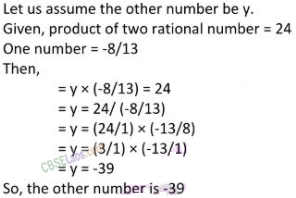
Question. 130 The product of two rational numbers is -7. If one of the number is -5, find the other?
Solution .
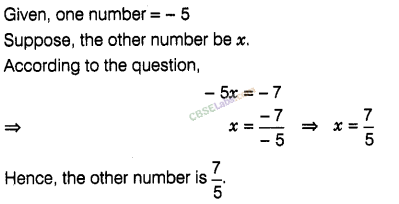
Question. 131 Can you find a rational number whose multiplicative inverse is -1?
Solution .
No, we cannot find a rational number whose multiplicative inverse is -1.
Question. 132 Find five rational numbers between 0 and 1.
Solution .

Question. 133 Find the two rational numbers whose absolute value is \( \frac { 1 }{ 5 }\) .
Solution .
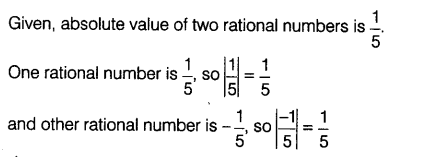
Question. 134 From a rope 40 m long, pieces of equal size are cut. If the length of one piece is \( \frac { 10 }{ 3 }\) m, find the number of such pieces.
Solution .
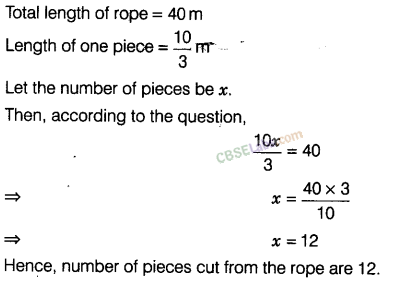
Question. 135 5 \( \frac { 1 }{ 2 }\) m long rope is cut into 12 equal pieces. What is the length of each piece?
Solution .
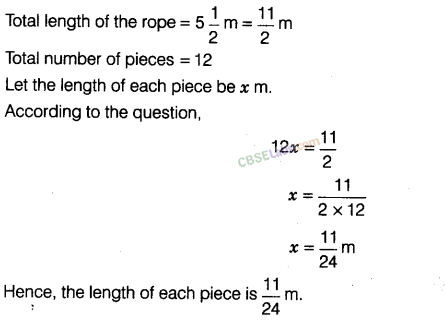
Question. 136 Write the following rational numbers in the descending order.

Solution .
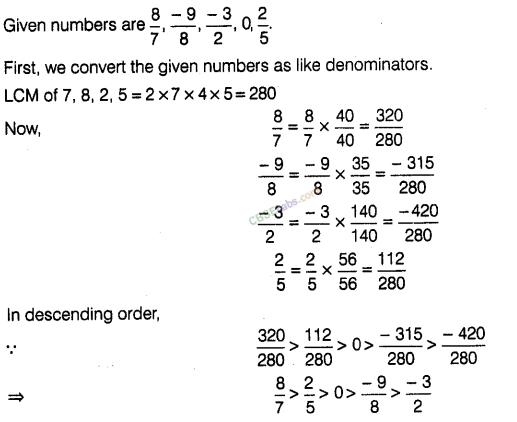
Question. 137 Find
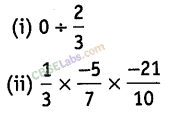
Solution .

Question. 138 On a winter day the temperature at a place in Himachal Pradesh was -16°C. Convert it in degree Fahrenheit (°F) by using the formula

Solution .
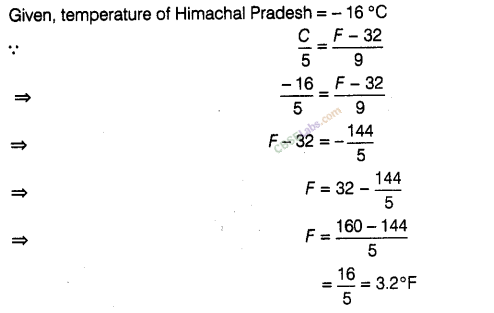
Question. 139 Find the sum of additive inverse and multiplicative inverse of 7.
Solution .
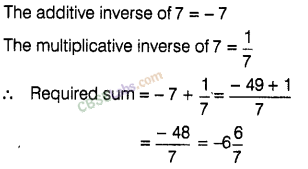
Question. 140 Find the product of additive inverse and multiplicative inverse of \( -\frac { 1 }{ 3 }\).
Solution .
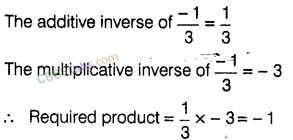
Question. 141 The diagram shows the wingspans of different species of birds. Use the diagram to answer the question given below
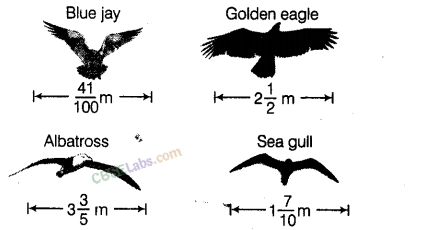
(a) How much longer is the wingspan of an Albatross than the wingspan of a Sea gull?
(b) How much longer is the wingspan of a Golden eagle than the wingspan of a Blue jay?
Solution .
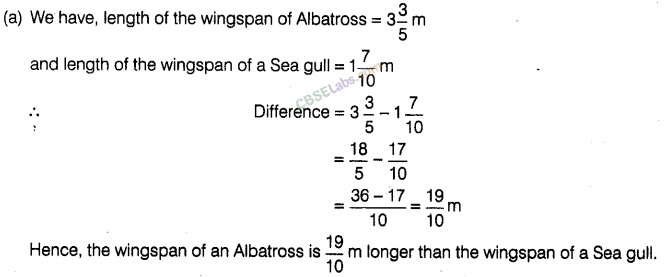
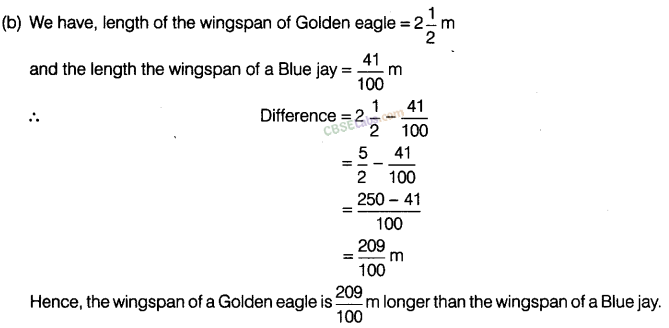
Question. 142 Shalini has to cut out circles of diameter 1 \( -\frac { 1 }{ 4 }\) cm from an aluminium strip of dimensions 8\( -\frac { 3 }{ 4 }\) cm by 1 \( -\frac { 1 }{ 4 }\) cm. How many full circles can Shalini cut? Also, calculate the wastage of the aluminium strip.

Solution .
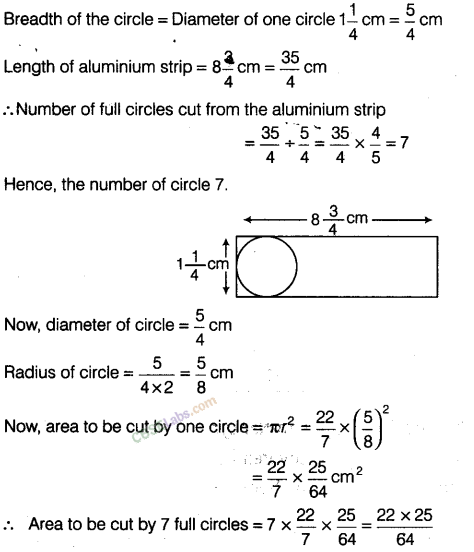
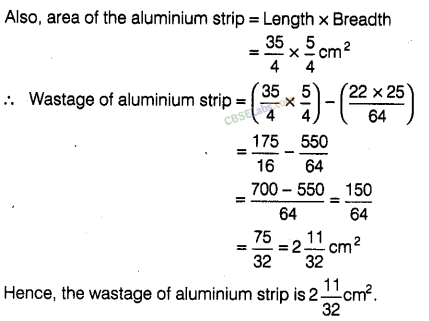
Question. 143 One fruit salad recipe requires \( -\frac { 1 }{ 2 }\) cup of sugar. Another recipe for the same fruit salad requires 2 tablespoons of sugar. If 1 tablespoon is 1 equivalent to \( -\frac { 1 }{ 16 }\) cup, how much more sugar does the first recipe require?
Solution .
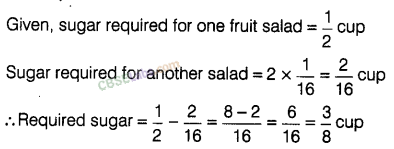
Question. 144 Four friends had a competition to see how far could they hop on one foot. The table given shows the distance covered by each.
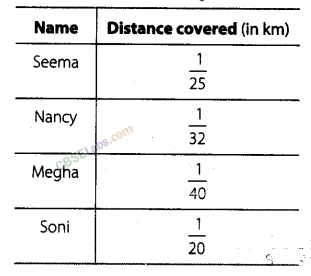
(a) How farther did Soni hop than Nancy?
(b) What is the total distance covered by Seema and Megha?
(c) Who walked farther, Nancy or Megha?
Solution .
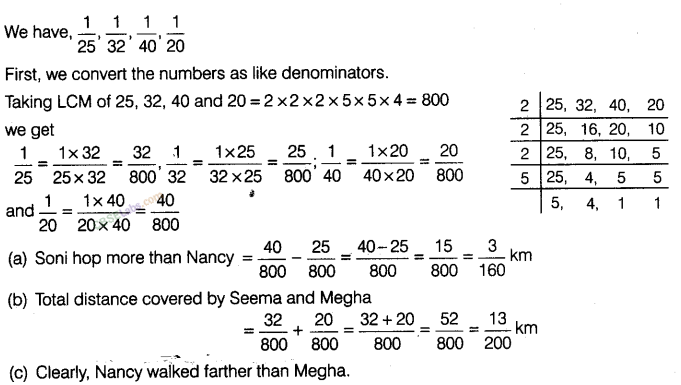
Question. 145 The table given below shows the distances, in kilo metres, between four villages of a state. To find the distance between two villages, locate the square, where the row for one village and the column for the other village intersect.
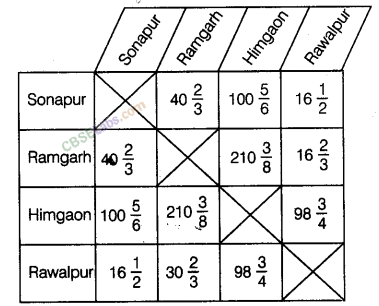
(a) Compare the distance between Himgaon and Rawalpur to Sonapur and Ramgarh?
(b) If you drove from Himgaon to Sonapur and then from Sonapur to Rawalpur, how far would you drive?
Solution .

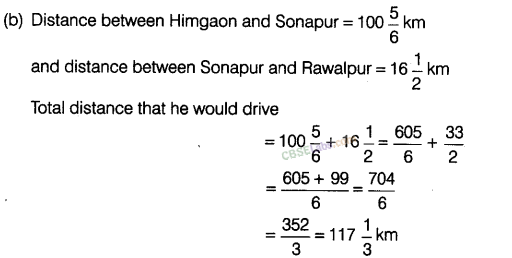
Question. 146 The table shows the portion of some common materials that are recycled.
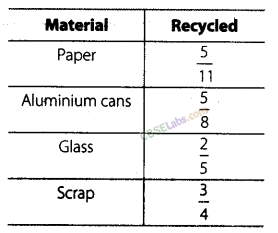
(a) Is the rational number expressing the amount of paper recycled more than \( -\frac { 1 }{ 2 }\) or less than \( -\frac { 1 }{ 2 }\) ?
(b) Which items have a Recycled amount less than \( -\frac { 1 }{ 2 }\) ?
(c) Is the quantity of aluminium fans recycled more (or less) than half of the quantity of aluminium cans?
(d) Arrange the rate of recycling the materials from the greatest to the smallest.
Solution .
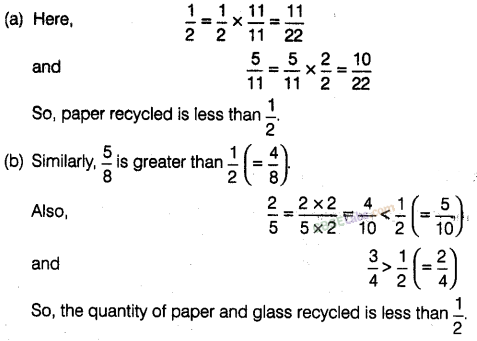
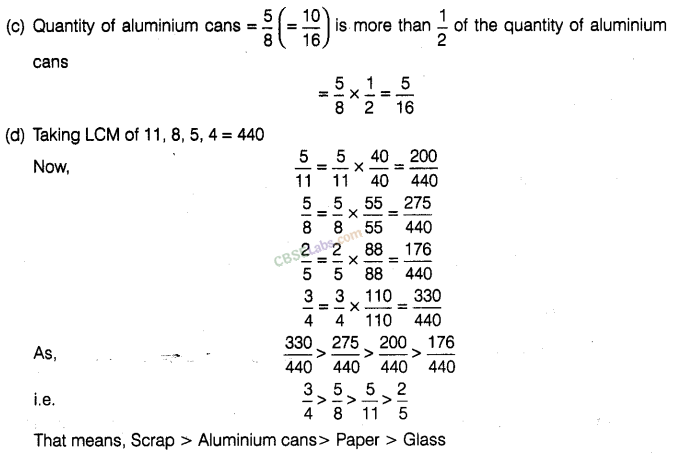
Question. 147 The overall width in cm of several wide-screen televisions are 97.28 cm,98\( -\frac { 4 }{ 9 }\) cm, 98\( -\frac { 1 }{ 25 }\) cm and 97.94 cm. Express these numbers as rational numbers in the form \( -\frac { p }{ q }\) and arrange the widths in ascending order.
Solution .
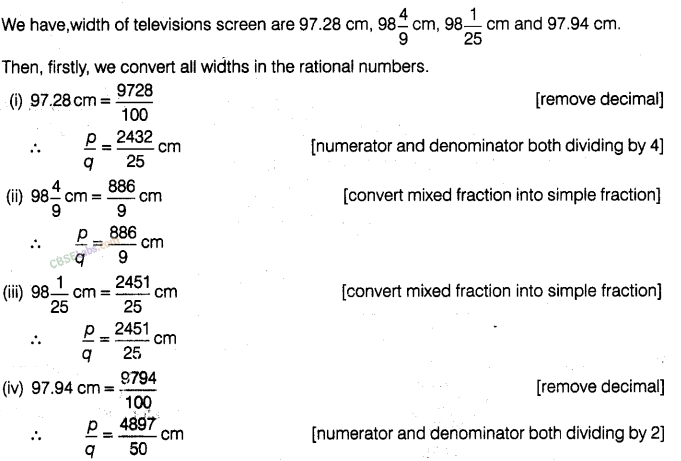
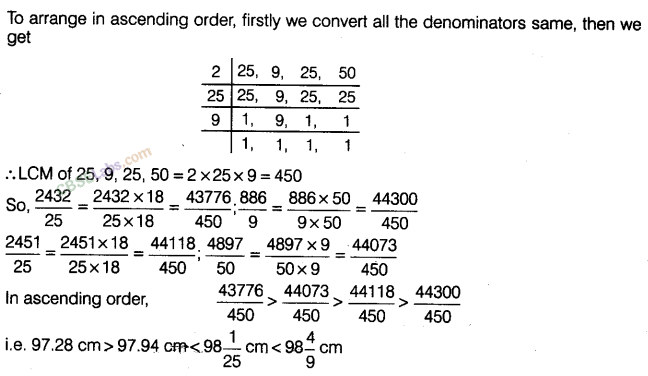
Question. 148 Roller coaster at an amusement park is \( -\frac { 2 }{ 3 }\) m high. If a new roller coaster is built that is \( -\frac { 3 }{ 5 }\) times the height of the existing coaster, what will be the height of the new roller coaster?
Solution .

Question. 149 Here is a table which gives the information about the total rainfall for several months compared to the average monthly rains of a town. Write each decimal in the form of rational number \( -\frac { p }{ q }\) .
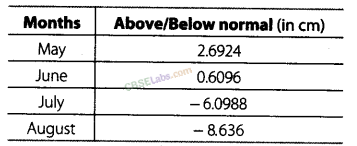
Solution .


Question. 150 The average life expectancies of males for several states are shown in the table. Express each decimal in the form \( -\frac { p }{ q }\) and arrange the states from the least to the greatest male life expectancy.
State-wise data are included below; more indicators can be found in the “FACTFILE” section on the homepage for each state.
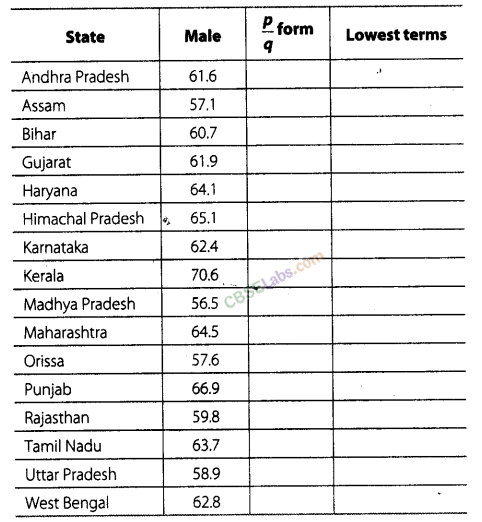
Source Registrar General of India (2003) SRS Based Abridged Lefe Tables. SRS Analytical Studies, Report No. 3 of 2003, New Delhi: Registrar General of India.
The data are for the 1995-99 period; states subsequently divided are therefore included in their pre-partition states (Chhatisgarh in MP, Uttaranchal in UP and Jharkhand in Bihar)
Solution .
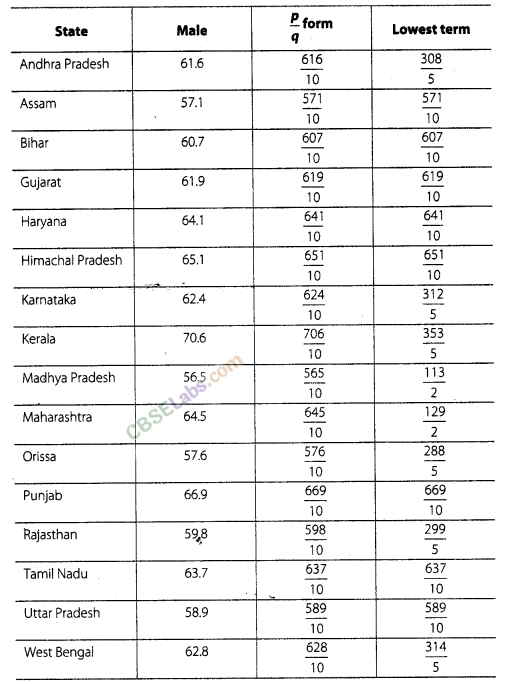
Arrangement of the states from the least to the greatest male life expectancy, Haryana, Tamil Nadu, West Bengal, Karnataka, Gujarat, AndhraPradesh, Bihar, Rajasthan, Uttar Pradesh, Orissa, Assam, Madhya Pradesh.
Question. 151 A skirt that is 35 \( \frac { 7 }{ 8 }\) cm long has a hem of 3\( \frac { 1 }{ 8 }\) cm. How tong will the skirt . be if the hem is let down?
Solution .

Question. 152 Manavi and Kuber each receives an equal allowance. The table shows the fraction of their allowance each deposits into his/her saving account and the fraction each spends at the mall. If allowance of each is Rs 1260, find the amount left with each.
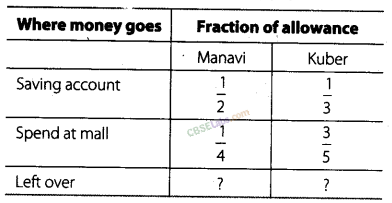
Solution .
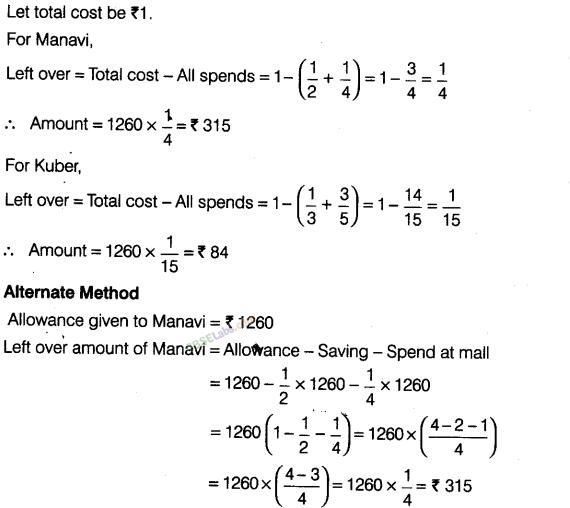
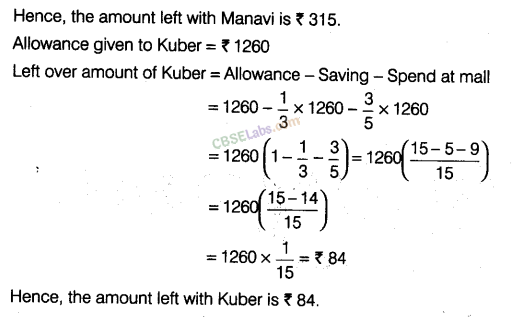
NCERT Exemplar Class 8 Maths Solutions
- Chapter 1 Rational Numbers
- Chapter 2 Data Handling
- Chapter 3 Square-Square Root and Cube-Cube Root
- Chapter 4 Linear Equations in One Variable
- Chapter 5 Understanding Quadrilaterals and Practical Geometry
- Chapter 6 Visualising Solid Shapes
- Chapter 7 Algebraic Expressions, Identities and Factorisation
- Chapter 8 Exponents and Powers
- Chapter 9 Comparing Quantities
- Chapter 10 Direct and Inverse Proportion
- Chapter 11 Mensuration
- Chapter 12 Introduction to Graphs
- Chapter 13 Playing with Numbers